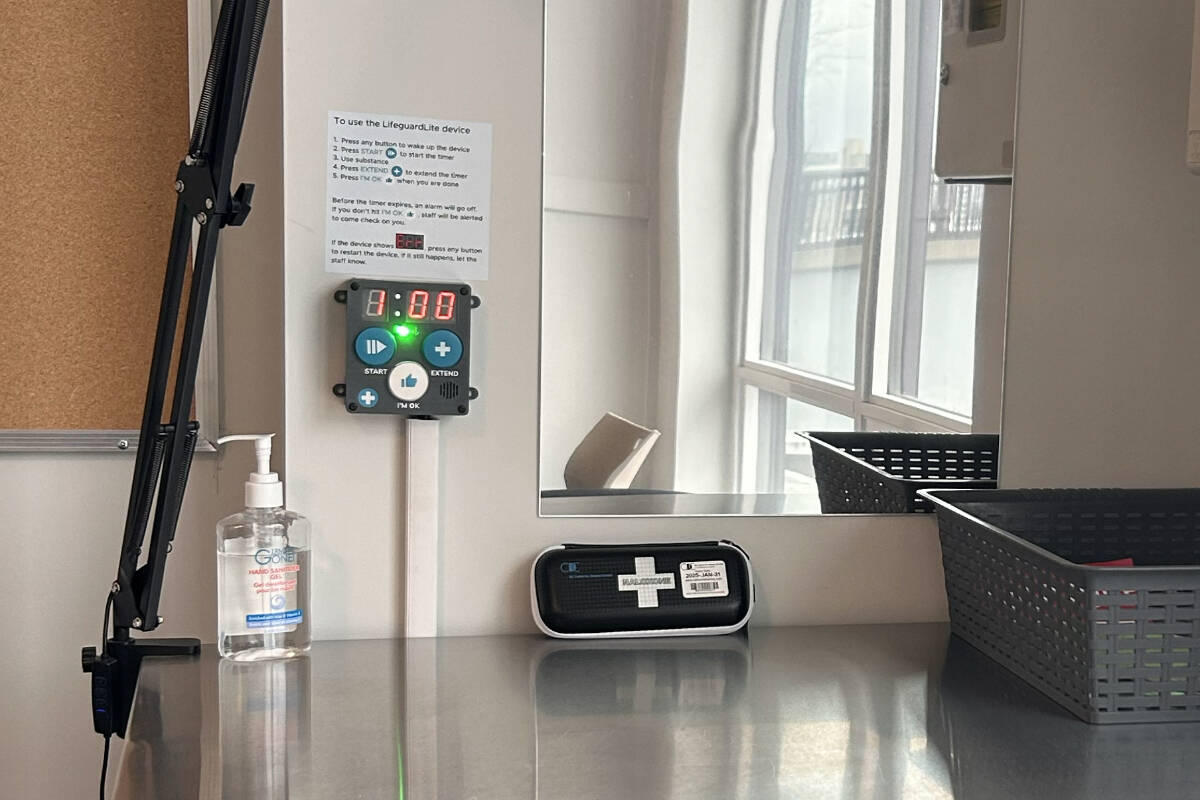The company behind an overdose prevention device designed for supportive housing sites says the tool has saved 29 lives in B.C. in the past year.
Fixed to a wall inside people’s rooms, the LifeguardLite works by giving residents who use drugs a one-minute window to ingest a substance and indicate that they are feeling okay. If they fail to hit the thumbs-up button on the device within that time, it automatically sends a notification to housing staff and 911 dispatchers that the resident needs help.
Since April 2023, when LifeguardLite began rolling out in B.C., maker Lifeguard Digital Health says the devices have been triggered about 2,200 times.
In each case, staff at the supportive housing site, transition house or shelter are instructed to immediately attend the resident’s room and, if needed, administer naloxone. Lifeguard says staff have saved 14 lives this way.
Once they have checked in on the resident, staff communicate with 911 dispatchers to indicate whether an ambulance is needed. Lifeguard says a further 15 lives have been saved by paramedics.
Its figures are verified through B.C. Emergency Health Services. BCEHS told Black Press Media it couldn’t independently confirm the numbers in time for publication, but indicated to Lifeguard in an email shared with Black Press that it is comfortable with the company sharing the numbers it has.
Most of those 29 people were suffering from overdoses, but Lifeguard’s supportive housing solutions manager, Jamie Sinclair, said the device has been useful in other ways too. One resident triggered the device when they woke up in cardiac arrest and another person used it when they had a severe asthma attack and couldn’t find their inhaler.
The instrument can also help with other emergencies. It monitors the temperature in residents’ rooms and notifies staff if it gets too hot or cold – an important feature for buildings that often lack air conditioning, Sinclair noted.
Staff can also send alarms through the LifeguardLite devices if there is a fire or carbon monoxide leak in the building. Sinclair said this feature is useful because fire alarms go off so frequently in supportive housing sites and shelters that residents don’t always take them seriously. An alert from LifeguardLite lets them know it’s not a false alarm.
The primary focus of LifeguardLite, though, is to counteract the toxic drug crisis, which claims an ever-increasing number of lives each year. By the BC Coroner Service’s most recent estimate, about seven people die from it every day.
Sinclair acknowledged 29 may seem like a small number when compared to the thousands of lives lost, but said that it represents 29 times friends and family didn’t have to mourn a loved one and 29 times a staff member didn’t have to find someone dead. She added that the device isn’t the solution to the toxic drug crisis, but it is one way to ensure fewer people die until broader policy changes and supports are implemented.
“This is about keeping people alive, so that they get the chance if and when they choose to change directions.”
READ ALSO: ‘Significant deficiencies’ in programs to curb toxic drug deaths: B.C auditor
READ ALSO: 2023 was the worst year for fatal toxic drug poisonings in B.C. history
There are about 1,000 of the devices throughout B.C. now. Lifeguard has received interest for around 7,000 more, but Sinclair said housing sites are waiting to see if they will be approved for funding.
BC Housing is offering $1 million in grants for various overdose prevention tools, with applications closing on April 5.
One of the other primary devices being used in B.C. is called the Brave Button. It allows supportive housing residents to hit a button when they need a check-in from staff. Its maker, Brave Technology Co-op, says the device has prevented more than 140 overdose deaths throughout 50 cities in the U.S. and Canada since 2018. It collects data through staff logs.
Both Lifeguard and Brave also offer overdose prevention apps, which each company says have prevented even more deaths. Brave said its app has saved 56 lives throughout Canada and the U.S. since 2018, while Lifeguard says its app has saved 85 people in B.C. specifically since 2020.

